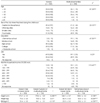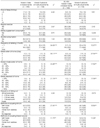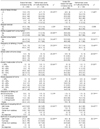Abstract
The Korean society has gone through a dramatic change in its population, with rapidly increasing number of multicultural families through international marriages since 1990s. This study investigated the differences between multicultural families and Korean families in three areas related to dietary behaviors: diet-related behaviors and perception, and food preferences. A cross-sectional analysis was performed in 500 Koreans from Korean families and 104 couples from the multicultural families with Vietnamese wives. More subjects from multicultural families grew up in the countryside, received less education and also had lower income than the subjects from Korean families. Multicultural families ate traditional Korean meals more often at home and dined out less often than Korean families. The multicultural families focused more attention on nutritional aspects of their diets than Korean families. The Vietnamese wives in multicultural families favored Vietnamese foods but they rarely ate those foods in Korea despite an easy accessibility to Vietnamese ingredients. In conclusion, the multicultural families had more traditional Korean dietary patterns than Korean families, which could have been influenced by their socioeconomic factors. Further research with a quantitative analysis is needed in future studies to understand the effect of dietary patterns on nutritional status and quality of life in multicultural and Korean families.
Figures and Tables
References
1. Cho YA. A study on evaluation of food behavior and nutritional risks of Vietnamese female immigrants in Korea. 2010. Kyung Hee University;50–53. Dissertation.
2. Choi JH, Lee GI. The study on the changes and prospects of food consumption pattern. 1995. Seoul: Korea Rural Economic Institute;19–39.
3. Chung ES. The effect of demographic characteristics on food expenditure pattern of urban household. Nonghyup Monthly Report. 2004. 557:1–18.
4. Hanh TTM, Komatsu T, Hung NT, Chuyen VN, Yoshimura Y, Tien PG, Yamamoto S. Nutritional status of middle-aged Vietnamese in Ho Chi Minh city. J Am Coll Nutr. 2001. 20(6):616–622.
5. He J, Klag MJ, Wu Z. Effect of immigration and related environmental changes on serum lipid levels in southwestern Chinese men. Am J Epidemiol. 1996. 144(9):839–849.
6. Iso H, Aaron RF, Kenneth K. Hemostatic variables in Japanese and Causian men. Plasma fibrinogen, factor VIIc, factor VIIIc, and von Willebrand factor and their relations to cardiovascular disease risk factors. Am J Epidemiol. 1989. 130(5):925–934.
7. Huang B, Rodriguez BL, Burchfiel CM, Chyou PH, Curb JD, Yano K. Acculturation and prevalence of diabetes among Japanese-American men in Hawaii. Am J Epidemiol. 1996. 144(7):674–681.
8. Hwang JY, Lee SE, Kim SH, Chung HW, Kim WY. Psychological distress is associated with inadequate dietary intake in Vietnamese marriage immigrant women in Korea. J Am Diet Assoc. 2010. 110(5):779–785.
9. Kim BR. The status of international marriage immigration and adaptation to Korean society of immigrants. 2008. Sogang University;34–35. Dissertation.
10. Kim JM, Lee NH. Analysis of the dietary life of immigrant women from multicultural families in the Daegu area. J Korean Diet Assoc. 2009. 15(4):405–418.
11. Kim KH. Effect of a food-related lifestyle on the consumption and satisfaction with Korean foods, and intention to revisit. J Korea Contents Assoc. 2010. 10(8):370–380.
12. Kim MS. Food away from home expenditure of the urban household : Effect of wive's employment. 1998. Seoul National University;10–18. Dissertation.
13. Kim SH, Kim WY, Lyu JE, Chung HW, Hwang JY. Dietary intakes and eating behaviors of Vietnamese female immigrants to Korea through marriage and Korean spouses and correlations of their diets. Korean J Community Nutr. 2009. 14(1):22–30.
14. Korea Immigration Service. The statistics of marriage immigrants. 2011. cited 2012 April 14. Available from http://www.immigration.go.kr.
15. Korean Educational Development Institute. Korean Education at a Glance (KEAG). 2008. cited 2012 September 21. Available from http://cesi.kedi.re.kr.
16. Lyu JE. Dietary characteristics of Vietnamese female marriage immigrants in Korea. 2008. Ewha Womens University;51–61. Dissertation.
17. Lyu JE, Yang YJ, Lee SE, Chung HW, Kim MK, Kim WY. Nutritional status of Vietnamese female marriage immigrants to Korea in relation to length of residence in Korea. Ann Nutr Metab. 2009. 55:317–324.
18. Ministry of Health & Welfare and Family Affairs. National survey on multicultural families. 2009. cited 2012 September 21. Available from http://www.mw.go.kr.
19. Park HR, Lee KY, Ryu JS. Analysis of food consumption patterns by income levels using annual report on the family income and expenditure survey. Korean J Community Nutr. 1997. 2(4):633–646.
20. Parrish JB. Implication of changing food habits for nutrition educators. J Nutr Educ. 1971. 2(4):140–146.
21. Raberg Kjollesdal MK, Holmboe-Ottesen G, Wandel M. Associations between food patterns, socioeconomic position and working situation among adult, working women and men in Oslo. Eur J Clin Nutr. 2010. 64(10):1150–1157.
22. Statistics Korea. Household income & expenditure trends in the first quarter 2011. 2011. cited 2012 September 21. Available from http://kostat.go.kr.
23. Turrell G, Kavanagh AM. Socio-economic pathways to diet: modelling the association between socio-economic position and food purchasing behavior. Public Health Nutr. 2006. 9(3):375–383.
24. Yang EJ, Chung HK, Kim WY, Bianchi L, Song WO. Chronic diseases and dietary changes in relation to Korean American's length of residence in the United States. J Am Diet Assoc. 2007. 107(6):942–950.
25. Yang W, Read M. Dietary pattern changes of Asian immigrants. Nutr Res. 1996. 16(8):1277–1293.




 PDF
PDF ePub
ePub Citation
Citation Print
Print










 XML Download
XML Download